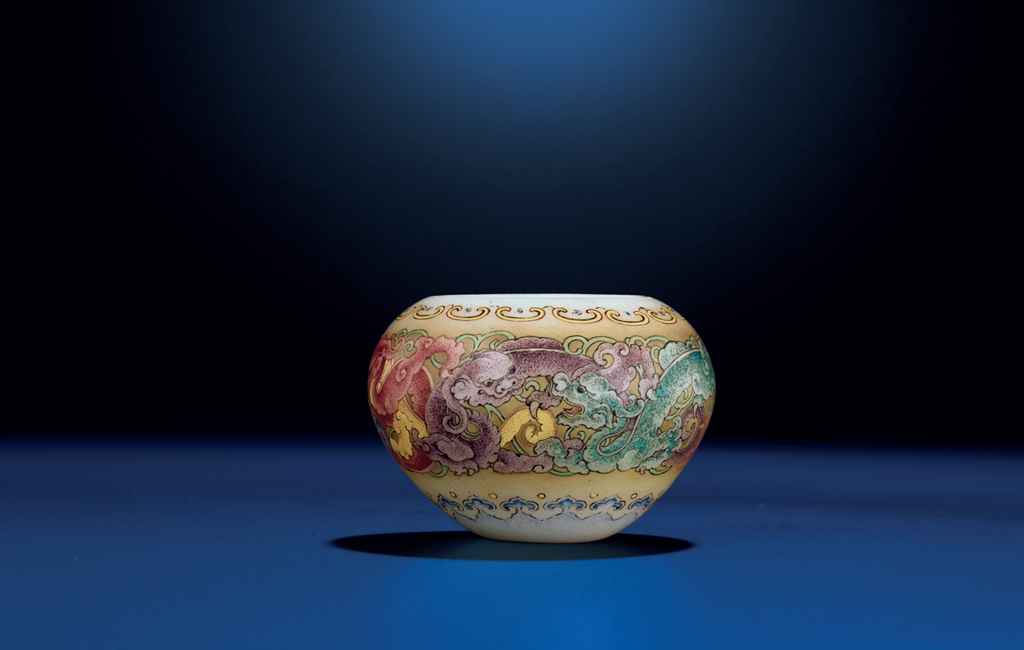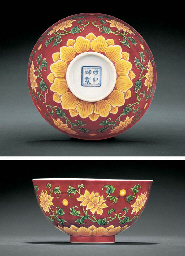A VERY RARE ENAMELLED YELLOW AND GREEN 'NINE BATS' BOWL WITH POLYCHROME DETAILSYongzheng six-character mark and of the period
Delicately-potted with deep rounded sides supported on a splayed foot, finely incised on the exterior with nine bats in flight, each carrying a beribboned double gourd, interspersed amidst trailing wispy clouds, all between a band of ruyi heads below the rim and a lappet band above the foot, the bats picked out in iron red, the fluttering ribbons in blue, the gourds in sea-green, all reserved on a pale yellow ground repeated on the interior, save for the white base inscribed with six-character mark within double circles. 12cm (4 6/8in) diam.Footnotes清雍正 黃地洋彩九蝠紋碗
青花「大清雍正年製」楷書款
Provenance: a British private collection, and thence by descent
來源:英國私人收藏,並由後人保存迄今
Notable for the delicacy of the designs and the soft enamelling palette, the present bowl is rare as it departs from the usual convention of green-enamelled decorative bowls on a yellow ground: this new decorative scheme represents an innovation introduced during the reign of the Yongzheng Emperor.
According to the Imperial Archives, vessels decorated with red, blue, white, green, purple and black enamels on yellow ground were referred to as a new category of wucai, which was introduced during the Yongzheng period; see Geng Baochang, Appraisal of Ming and Qing porcelain, Hong Kong, 1993, p.248. The new decorative scheme was basically an improvement of the three-colour sancai pattern of green, yellow and white, with the exception that the elements that had remained white- the bats and the ribbons- are now overpainted in in red and blue, and the sea-green gourds had been given were decorated with beige spots.
The combined designs of nine bats and nine gourds is particularly auspicious and deeply rooted in Chinese culture. in the first place, bats fu are homophone with the word for happiness fu. Double gourds are popular symbols of longevity and are associated with Li Tiegui, one of the Eight Daoist Immortals, who is often depicted holding a double gourd containing the elixir of Immortality. Finally, the repetition of bats and gourds designs nine times emphasises the desire for ever-lasting happiness and longevity, with the number nine evoking infinity, being homophone with the word for infinity jiu 久, and partly because nine is the product of 'three times three' - the basic unit of three being Heaven, Earth and Man.
Compare with a nearly-identical yellow-ground bowl decorated with polychrome designs of bats carrying gourds amidst clouds, Yongzheng mark and of the period, from the Qing Court Collection, illustrated in The Complete Collection of Treasures of the Palace Museum. Porcelains with Cloisonne Enamel Decoration and Famille Rose Decoration, Shanghai, 1999, p.95, no.83; another similar bowl, Yongzheng mark and of the period, is illustrated by S.Jenyns, Later Chinese Porcelain, London, 1971, pl.69, no.3.
A very similar bowl, Yongzheng mark and period, was sold at Sotheby's Hong Kong, 11 July 2020, lot 3620. Compare also with a nearly-identical enamelled yellow-ground 'nine bats' bowl, Yongzheng mark and of the period, which was sold at Christie's London, 3 November 2020, lot 34; see also another similar bowl but decorated with twelve bats, Yongzheng mark and of the period, which was sold at Sotheby's Hong Kong, 5 April 2017, lot 6.
A VERY RARE ENAMELLED YELLOW AND GREEN 'NINE BATS' BOWL WITH POLYCHROME DETAILSYongzheng six-character mark and of the period
Delicately-potted with deep rounded sides supported on a splayed foot, finely incised on the exterior with nine bats in flight, each carrying a beribboned double gourd, interspersed amidst trailing wispy clouds, all between a band of ruyi heads below the rim and a lappet band above the foot, the bats picked out in iron red, the fluttering ribbons in blue, the gourds in sea-green, all reserved on a pale yellow ground repeated on the interior, save for the white base inscribed with six-character mark within double circles. 12cm (4 6/8in) diam.Footnotes清雍正 黃地洋彩九蝠紋碗
青花「大清雍正年製」楷書款
Provenance: a British private collection, and thence by descent
來源:英國私人收藏,並由後人保存迄今
Notable for the delicacy of the designs and the soft enamelling palette, the present bowl is rare as it departs from the usual convention of green-enamelled decorative bowls on a yellow ground: this new decorative scheme represents an innovation introduced during the reign of the Yongzheng Emperor.
According to the Imperial Archives, vessels decorated with red, blue, white, green, purple and black enamels on yellow ground were referred to as a new category of wucai, which was introduced during the Yongzheng period; see Geng Baochang, Appraisal of Ming and Qing porcelain, Hong Kong, 1993, p.248. The new decorative scheme was basically an improvement of the three-colour sancai pattern of green, yellow and white, with the exception that the elements that had remained white- the bats and the ribbons- are now overpainted in in red and blue, and the sea-green gourds had been given were decorated with beige spots.
The combined designs of nine bats and nine gourds is particularly auspicious and deeply rooted in Chinese culture. in the first place, bats fu are homophone with the word for happiness fu. Double gourds are popular symbols of longevity and are associated with Li Tiegui, one of the Eight Daoist Immortals, who is often depicted holding a double gourd containing the elixir of Immortality. Finally, the repetition of bats and gourds designs nine times emphasises the desire for ever-lasting happiness and longevity, with the number nine evoking infinity, being homophone with the word for infinity jiu 久, and partly because nine is the product of 'three times three' - the basic unit of three being Heaven, Earth and Man.
Compare with a nearly-identical yellow-ground bowl decorated with polychrome designs of bats carrying gourds amidst clouds, Yongzheng mark and of the period, from the Qing Court Collection, illustrated in The Complete Collection of Treasures of the Palace Museum. Porcelains with Cloisonne Enamel Decoration and Famille Rose Decoration, Shanghai, 1999, p.95, no.83; another similar bowl, Yongzheng mark and of the period, is illustrated by S.Jenyns, Later Chinese Porcelain, London, 1971, pl.69, no.3.
A very similar bowl, Yongzheng mark and period, was sold at Sotheby's Hong Kong, 11 July 2020, lot 3620. Compare also with a nearly-identical enamelled yellow-ground 'nine bats' bowl, Yongzheng mark and of the period, which was sold at Christie's London, 3 November 2020, lot 34; see also another similar bowl but decorated with twelve bats, Yongzheng mark and of the period, which was sold at Sotheby's Hong Kong, 5 April 2017, lot 6.




.jpg)
.jpg)









Try LotSearch and its premium features for 7 days - without any costs!
Be notified automatically about new items in upcoming auctions.
Create an alert